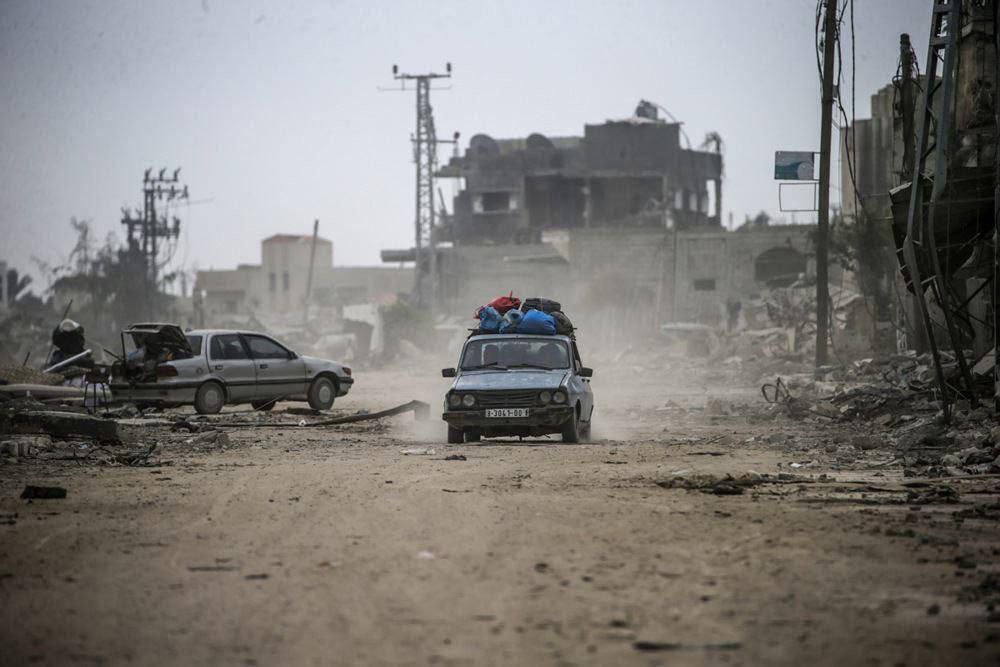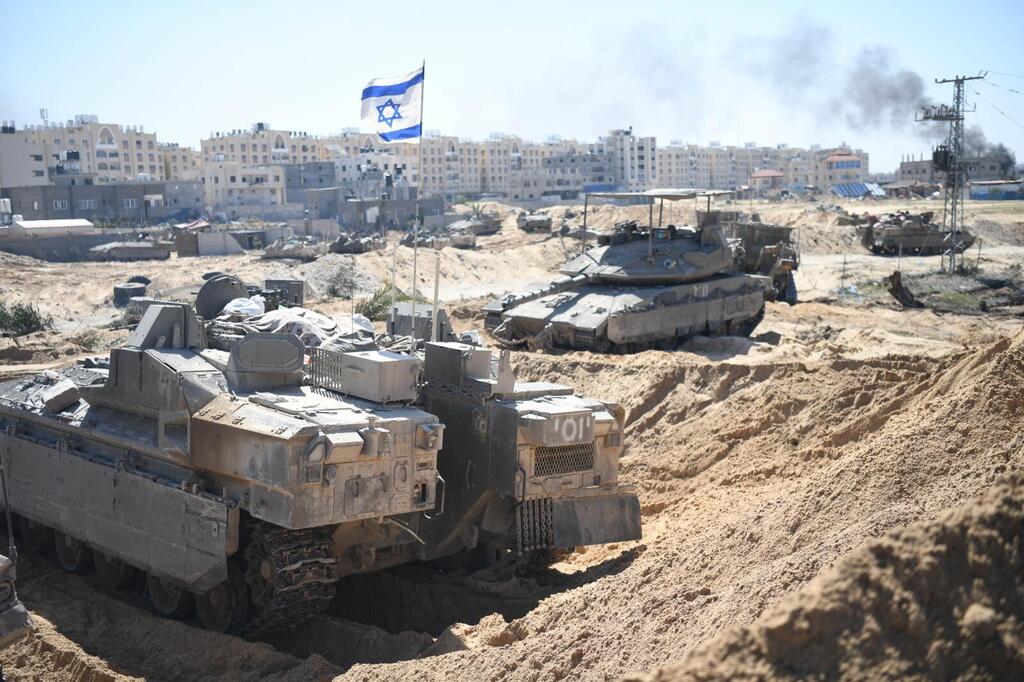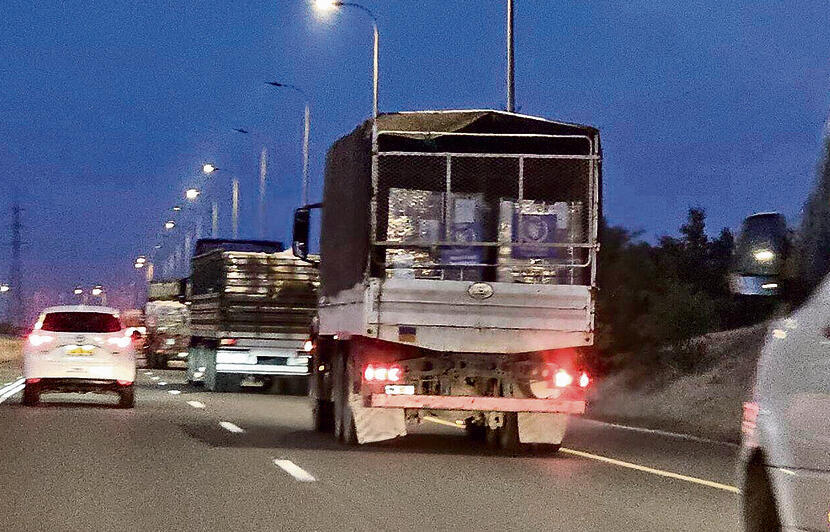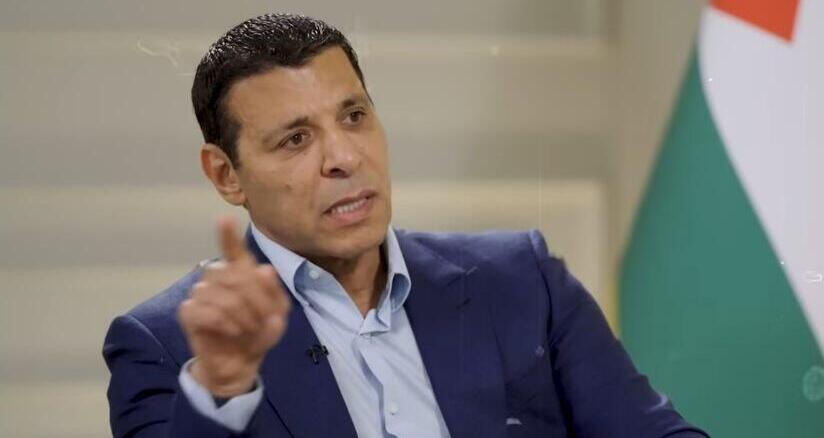Getting your Trinity Audio player ready...
Four days after the IDF's withdrawal from Khan Younis, alongside the masses of residents returning to their destroyed homes, Hamas operatives have also been seen beginning to reassert their control over the southern Gaza Strip city. They are careful not to move in groups, maintaining a stern demeanor and carrying batons to re-establish their grip on the population.
As Israel insists on not allowing thousands of Fatah operatives living in the Gaza Strip to replace Hamas' rule, even as a bureaucratic mechanism, the passing months make it increasingly difficult to achieve even the more modest goals of the war: reducing Hamas' civilian, not just military, control, especially after the IDF's main military operation ended this week, to continue with limited raids.
The Air Force will not target every municipal worker currently clearing debris from the streets with a tractor, nor will it strike every Gazan head of sanitation or regional education department manager still receiving their salary from Hamas.
Even now, the IDF struggles to identify and target the intact internal security mechanisms of Hamas, which remain operational and instill fear among Gaza's civilians. These forces are joined by members of the military wing in disguise and without carrying weapons out in the open.
In the absence of an alternative governance structure and continued inaction, Israel effectively perpetuates Hamas' civilian rule in Gaza, aiding in its resurgence for years to come.
Hamas' "enforcers" are only attacked if a real opportunity presents itself. For example, such a group of Hamas enforcers was identified at Shijaiyah’s Kuwait Square last month and immediately struck from the air, with most members eliminated.
The IDF and Shin Bet reported that the mayor of Al-Maghazi was recently killed for serving as the head of the local emergency committee for Hamas. However, the challenge of locating and targeting the dispersed workforce of thousands of Hamas operatives is akin to finding a needle in a haystack.
In the bustling markets of Jabaliya, Hamas operatives are currently maintaining order and preventing price gouging. According to defense establishment data, there has been notable success: food prices in Gaza have significantly dropped in the past month, indicating economic stabilization in the region.
The military anticipates similar scenes in Khan Younis soon. The defense establishment notes Hamas has also reduced taxes to ease the burden on the population, especially ahead of Eid al-Fitr, marking the end of Ramadan.
In areas where the IDF has yet to operate, like Rafah and central Gaza Strip towns, Hamas' civil control is considered moderate, including police enforcement of law and order and civilian daily routines.
The IDF is preparing for actions against two Hamas brigades not yet addressed: in Deir al-Balah and neighboring central towns like Nuseirat, and in the city of Rafah.
The government has inadvertently turned Rafah into a global rallying point against continued IDF ground operations in Gaza, with officers warning soldiers in units poised to operate in Rafah to "prepare for many casualties," especially if hundreds of thousands of residents and displaced persons do not leave.
Jordan bypasses protests
In recent nights, an extraordinary sight unfolded on the roads of southern Israel: over 60 Jordanian trucks journeyed from the southern Jordan Valley, through the northern Negev and Arava Valley, to the Nitzana crossing bordering Sinai. After several hours of inspection, they continued along Border Highway 10 to the Kerem Shalom crossing and into Gaza.
This route, starting from the Hashemite Kingdom and ending in the small enclave, is escorted by IDF military police and army logistics and technology units from the Allenby Bridge to the western Negev outskirts.
Deliberately chosen to head from the south and significantly circuitous, this path ensures that local residents and potential protesters do not notice and block these foreign trucks.
Mainly carrying food, water—lots of water, and some medicines, these donations from international aid organizations bear the Jordanian government's seal to somewhat ease the ongoing protests in Amman for about two weeks.
Security officials believe this Jordanian aid, like the flour Israel must bring into Gaza and the new aid routes opened through Ashdod Port and Erez crossing, is unnecessary. According to all security monitoring systems, there's no real famine in Gaza. Bakeries are full, and a humanitarian crisis is not expected. While the economic situation is dire, there's no indication of famine.
Hamas gets aid charge-free
Israel diligently shares daily images of Gaza's markets brimming with goods to international media and diplomatic representatives. Yet, Israeli officials are frustrated over the dramatic expansion of aid to nearly 500 truckloads daily from every possible direction, including from the developing and already operational Gaza pier, given to Hamas charge-free instead of as a key bargaining chip in a deal for the release of hostages in exchange for terrorists.
Humanitarian aid airdrop over northern Gaza
The Israeli concession is due to heavy international and U.S. pressure following the accidental killing of seven foreign aid workers in an IDF attack last week, sparking international outrage. In reality, thousands of tons of food entering Gaza partially reach thousands of Hamas' military wing operatives: distribution is carried out by foreign aid workers, but ultimately, the forklift operator or truck driver is Palestinian, as are the distribution points' ends.
According to the Coordinator of Government Activities in the Territories, Major General Ghassan Alian, who is becoming the most influential general at the General Staff and appearing in nearly every Cabinet discussion, since the war outbreak, about 21,000 aid trucks have entered Gaza through Kerem Shalom and Rafah crossings, with more than 272,000 tons of food and about 30,000 tons of water.
Fear Palestinian symbols may soon be free
The number of IDF officers and soldiers addressing civilian issues within the Gaza Strip is steadily increasing, more than tripling since the war began. Far from establishing martial law, the IDF’s allowance for civilian existence in Gaza is minimal, aimed at basic subsistence but increasingly entrenching Israel's indirect occupation of the area.
Expectations for a multinational force from moderate Sunni countries to enter Gaza are not materializing. The only armed personnel from countries like the UAE in Gaza are security for field hospitals they've established in the territory.
More and more security experts view Fatah, particularly its loosely organized presence in Gaza, as an alternative to Hamas' rule that would be a lesser evil for Israel. Former Palestinian Authority senior Mohammed Dahlan, seen as a secular and Western figure, is described by Israeli security sources as effectively the frontman for Hamas.
Now, against the backdrop of troop withdrawals from Khan Younis, seasoned combat officers and military scholars, deep into their fifth decade of life and recently emerging from months of maneuvering in the Gaza Strip, estimate that Hamas will be decisively defeated, in a best-case scenario, only by 2026 or 2027, even after its last two brigades are hopefully dismantled this year.
Military sources say, "We will not be in Gaza permanently. We'll return for extensive raids deep into the territory to defeat a terror army built over 15 years. Meanwhile, the achievements of the forces that fought in Gaza are eroding, and there's no conclusive political solution."
Security officials are concerned that the apparent calm in the West Bank is also fragile, especially in a scenario involving a mass release of Palestinian murderers in a deal for releasing hostages in exchange for terrorists.
IDF Chief of Staff Herzi Halevi said the IDF could handle any repercussions of the deal, as long as Israel fulfills its moral duty to bring the hostages home. However, Hamas will likely demand the release of figures like Marwan Barghouti. Their return to the Palestinian street, particularly to the West Bank, could ignite the region.










